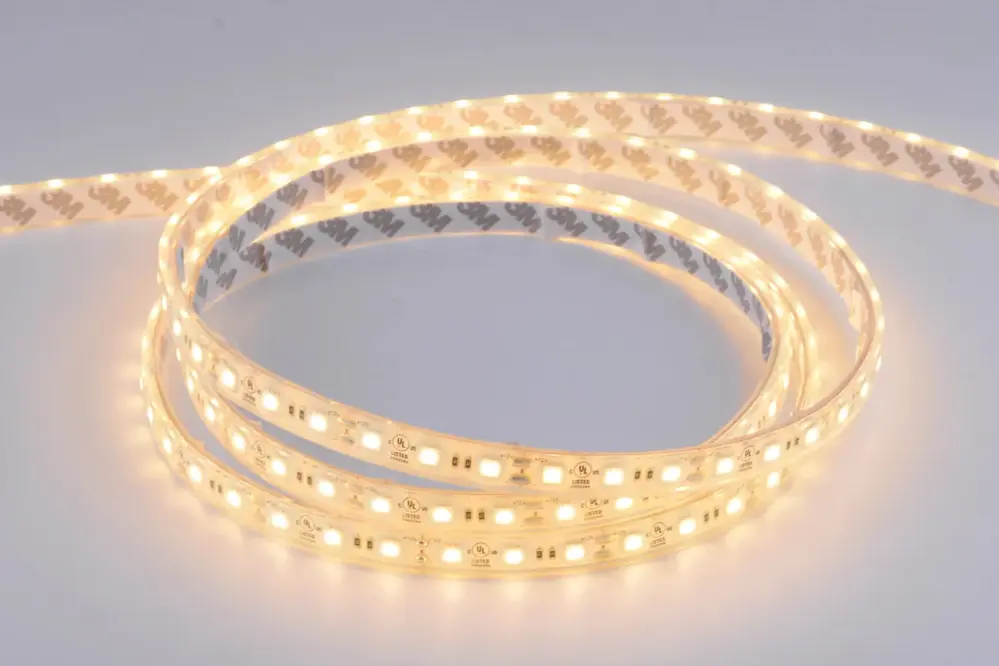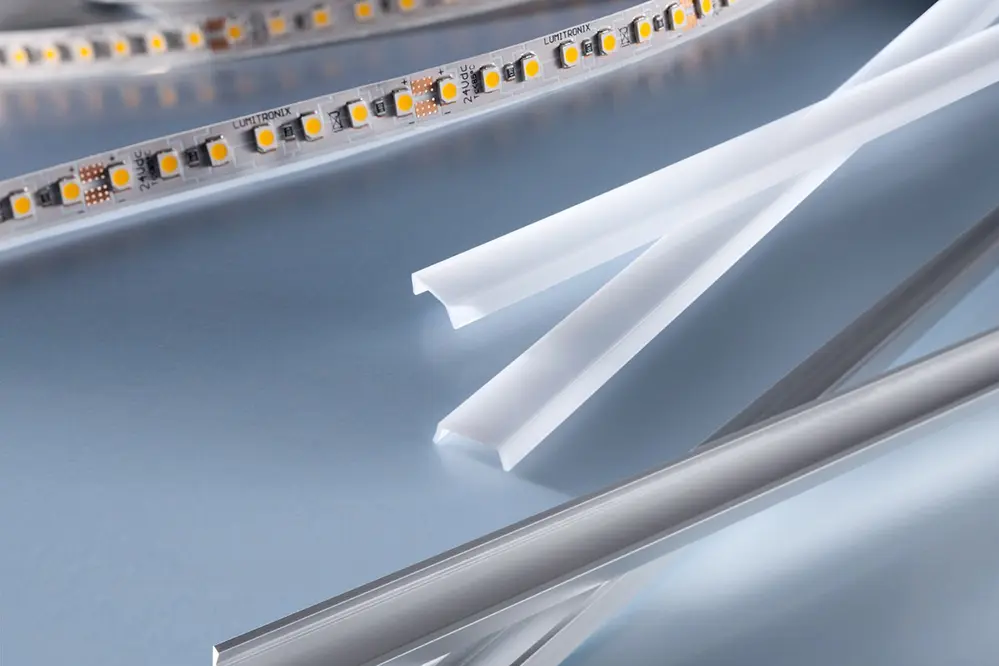Wondering if it’s safe to touch LED strip lights with your hands? You’re in the right place. We have the expertise to guide you through the safety aspects of handling these popular lighting solutions.
You can touch LED strip lights with hands as they emit minimal heat and are designed for safe handling, but ensure they are unplugged during installation or maintenance.
Want to learn more about the safety features of LED strip lights and best practices for handling them? Keep reading to discover everything you need to know.
Understanding LED Strip Lights

LED strip lights, captivating in their simplicity, revolutionize the way we illuminate our spaces with their vibrant efficiency and versatility.
These lights, using advanced technology, consist of a flexible circuit board populated with tiny, efficient LEDs. The innovative design allows them to be installed almost anywhere, offering a spectrum of color options and dynamic lighting effects. This adaptability makes LED strip lights an integral element in both residential and commercial environments, enhancing atmospheres with their sleek elegance.
Fundamentally, these lights operate on a low-voltage DC power supply, contributing to their safety. By utilizing energy-efficient LEDs, the lights produce minimal heat, thereby diminishing any fire hazards typically associated with traditional lighting.
Ultimately, the allure of LED strip lights extends beyond their aesthetics, as they represent a convergence of safety, efficiency, and functionality. Whether illuminating a creative workspace, accentuating architectural features, or simply creating ambiance, these lights empower users to explore and harness the potential of innovative lighting solutions in transformative ways.
Materials Used in LED Strips

LED strip lights are composed of advanced components including semiconductor materials that convert electricity into light, metallic substrates, and heat-resistant, yet flexible, polymers. These elements work in harmony, enabling LEDs to emit brilliant light while optimizing energy efficiency and longevity.
Such materials have revolutionized lighting by combining reduced heat emission with durability, assuring not only performance but also safety for frequent handling and use.
Silicon and Plastic Components
Silicon and plastic materials in LED strip lights serve as foundational elements, ensuring their robust construction. These materials offer a flexible yet resilient housing for the LED components.
In addition to their mechanical integrity, these materials provide a “cool-to-the-touch” experience. This is why handling LED strips, even while illuminated, involves minimal safety concerns.
Silicon’s heat resistance and plastic’s lightweight nature form the backbone of LED strip light safety.
Silicon, known for its heat-resistance, and plastic, for its lightness, protect the LED circuit. Together, they allow users to handle LED strips confidently, knowing that these components shield against excessive heat and mechanical wear, enhancing both usability and security.
Electrical Conductors
LED strip lights utilize low-voltage electricity.
This low-voltage design minimizes the risks typically associated with electrical conductors. The power levels used in LED strips are usually far below the dangerous thresholds of electrical shock, making it a safe option for everyday applications. Importantly, the sensitive design ensures user protection even during accidental contact.
Electricity flows through copper tracks.
Copper, with its excellent conductivity, ensures efficient power delivery to the LEDs – this keeps the lights shining bright without overheating the circuits they traverse. In fact, meticulous engineering guarantees that these conductive paths are well-encapsulated, securing the strip against potential mishandling.
As we transition into more sustainable lighting solutions, the thoughtful integration of safe electrical conductors in products like LED strips becomes critically important. With upcoming innovations expected to amplify their efficiency, the future looks brilliantly bright for LED technology, underscoring an electrifying era of safety and ingenuity.
Safety Standards for LED Lights
LED lighting technology stands on strong safety principles.
Globally recognized standards guide the design and manufacturing of LED lights. These standards are set to ensure the utmost protection for consumers while promoting the sustainable development of lighting technology. Specifically, compliance with these regulations includes rigorous testing of materials used in production, as well as verifying the product’s performance in various operating conditions.
Compliance increases reliability and consumer confidence.
The industry’s commitment to adhering to – and often exceeding – these stringent safety requirements is not only commendable but also crucial in maintaining trust. Consumers expect their LED products to be safe, reliable, and efficient.
Regional and international certifications underscore the industry’s dedication to implementing rigorous safety processes. For instance, ANSI in the United States and the IEC globally are instrumental in setting these standards, ensuring that the products you purchase today meet stringent requirements. Such consistency assures users of the reliability and safety of LEDs, shining a light on a future, bright and secure.
Handling LED Strip Lights
When it comes to handling LED strip lights, you’re indeed in a position of familiarity with advanced technology, which is truly exciting. These strips are designed with safety in mind, allowing users to handle them with confidence knowing their voltage presents no immediate risk, and the construction generally precludes any harmful exposure.
Can I Touch LED Strip Lights with Hands?
In an advancing world rich with safety-certified technologies, the question arises: can I touch LED strip lights with hands?
The reassuring answer is yes, you can safely touch LED strip lights with your hands. Modern LED strip lights are designed to emit minimal heat and operate at low voltages, ensuring user safety during everyday interaction.
It’s important to remember that LED strip lights are crafted with protective coatings, insulating any electrical components from direct contact. Thus, by design, they mitigate risks and empower users with their intuitive utility.
While handling any electronic device requires a degree of cautious respect, the construction of LED strip lights negates the necessity for concerns of shock or burns, promoting an interactive and engaging user experience.
Take pride and comfort in knowing that these luminescent marvels are made for you to explore with both hands.
Precautions and Safety Tips
When working with LED strip lights, it’s essential to embrace an informed approach. Thoughtful handling, in conjunction with a keen awareness of any potential hazards, promotes a harmonious interaction.
Always disconnect power before installing or adjusting LED strips. This ensures you’re protected from unforeseen electrical incidents.
Additionally, ensure your hands are dry and clean, preventing any moisture-induced conductivity.
Mind the surrounding materials; some surfaces might be susceptible to the adhesive or heat, even if minimal.
If soldering is required, a well-ventilated area and appropriate protective gear should be utilized. This guards against inhaling any harmful fumes or sustaining burns.
Finally, once setup is complete, there’s little else to worry about. Regular maintenance checks will only enhance your illuminating experience.
Common Concerns with Touching LED Lights
Though LED strip lights are renowned for their low heat output and user-friendliness, some individuals still express concern about potential risks. These apprehensions often stem from worries related to electrical shocks, heat generation, or the impact on light longevity. However, with proper care and basic safety practices like disconnecting the power source during handling, these concerns can be confidently and effectively addressed.
Electrical Shock Risks
While LED strip lights present minimal risks, it’s paramount to remain aware of potential electrical shock hazards. During installation or maintenance, always ensure the power source is disconnected.
- Dry Hands: Always handle with dry hands to avoid moisture-induced conductivity.
- Proper Insulation: Verify that all electrical connections are adequately insulated.
- Voltage Compliance: Ensure the strips match the voltage requirements of the power source.
- Manufacturer’s Instructions: Always adhere to the guidelines provided by the LED manufacturer.
Mitigating these risks enhances safety and ensures a worry-free experience with your lighting.
By taking these precautions, you can confidently enjoy the brilliance of LED technology without compromise.
Heat Generation Issues
LED strip lights are known for their energy efficiency, leading to significantly lower heat emission compared to traditional lighting options.
- Minimal Heat Output: Unlike incandescent bulbs, LEDs operate at much cooler temperatures.
- Reduced Fire Risk: Lower heat levels minimize the potential for fire hazards.
- Efficient Thermal Management: Many LED strips are designed with heat-dissipating materials, further ensuring safety.
- Prolonged Lifespan: Reduced heat generation contributes to the longer lifespan of the LED strips.
Efficient heat management optimizes both performance and longevity, making LED strip lights a safe choice for various applications.
Regular inspection and proper installation practices will further mitigate any heat concerns, ensuring secure and durable lighting solutions.
Conclusion
This article delves into the question of whether it’s safe to touch LED strip lights with hands, a common concern for many as these lights become a popular choice in home decor. The discussion begins by highlighting the energy efficiency and minimal heat emission of LED lights, which make them a safer alternative to traditional lighting options.
Understanding the safety aspects of LED strip lights is crucial, especially as their use continues to grow. The article emphasizes the importance of being informed about how to handle these lights safely, ensuring that users can enjoy their benefits without worry.
Readers will find valuable insights and practical tips for safely incorporating LED strip lights into their living spaces. By exploring these guidelines, the article aims to enhance the reader’s experience with LED lighting, providing the knowledge needed to use them confidently and effectively.





